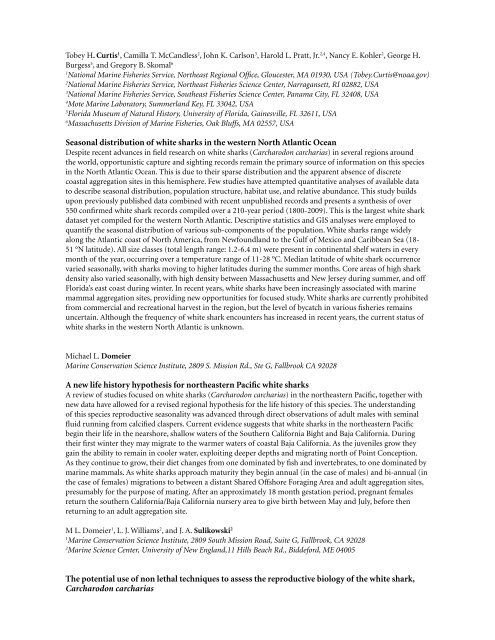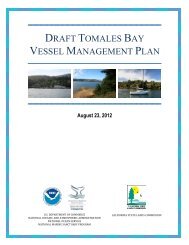Symposium program - Gulf of the Farallones National Marine ...
Symposium program - Gulf of the Farallones National Marine ...
Symposium program - Gulf of the Farallones National Marine ...
You also want an ePaper? Increase the reach of your titles
YUMPU automatically turns print PDFs into web optimized ePapers that Google loves.
Tobey H. Curtis 1 , Camilla T. McCandless 2 , John K. Carlson 3 , Harold L. Pratt, Jr. 2,4 , Nancy E. Kohler 2 , George H.<br />
Burgess 5 , and Gregory B. Skomal 6<br />
1<br />
<strong>National</strong> <strong>Marine</strong> Fisheries Service, Nor<strong>the</strong>ast Regional Office, Gloucester, MA 01930, USA (Tobey.Curtis@noaa.gov)<br />
2<br />
<strong>National</strong> <strong>Marine</strong> Fisheries Service, Nor<strong>the</strong>ast Fisheries Science Center, Narragansett, RI 02882, USA<br />
3<br />
<strong>National</strong> <strong>Marine</strong> Fisheries Service, Sou<strong>the</strong>ast Fisheries Science Center, Panama City, FL 32408, USA<br />
4<br />
Mote <strong>Marine</strong> Laboratory, Summerland Key, FL 33042, USA<br />
5<br />
Florida Museum <strong>of</strong> Natural History, University <strong>of</strong> Florida, Gainesville, FL 32611, USA<br />
6<br />
Massachusetts Division <strong>of</strong> <strong>Marine</strong> Fisheries, Oak Bluffs, MA 02557, USA<br />
Seasonal distribution <strong>of</strong> white sharks in <strong>the</strong> western North Atlantic Ocean<br />
Despite recent advances in field research on white sharks (Carcharodon carcharias) in several regions around<br />
<strong>the</strong> world, opportunistic capture and sighting records remain <strong>the</strong> primary source <strong>of</strong> information on this species<br />
in <strong>the</strong> North Atlantic Ocean. This is due to <strong>the</strong>ir sparse distribution and <strong>the</strong> apparent absence <strong>of</strong> discrete<br />
coastal aggregation sites in this hemisphere. Few studies have attempted quantitative analyses <strong>of</strong> available data<br />
to describe seasonal distribution, population structure, habitat use, and relative abundance. This study builds<br />
upon previously published data combined with recent unpublished records and presents a syn<strong>the</strong>sis <strong>of</strong> over<br />
550 confirmed white shark records compiled over a 210-year period (1800-2009). This is <strong>the</strong> largest white shark<br />
dataset yet compiled for <strong>the</strong> western North Atlantic. Descriptive statistics and GIS analyses were employed to<br />
quantify <strong>the</strong> seasonal distribution <strong>of</strong> various sub-components <strong>of</strong> <strong>the</strong> population. White sharks range widely<br />
along <strong>the</strong> Atlantic coast <strong>of</strong> North America, from Newfoundland to <strong>the</strong> <strong>Gulf</strong> <strong>of</strong> Mexico and Caribbean Sea (18-<br />
51 °N latitude). All size classes (total length range: 1.2-6.4 m) were present in continental shelf waters in every<br />
month <strong>of</strong> <strong>the</strong> year, occurring over a temperature range <strong>of</strong> 11-28 °C. Median latitude <strong>of</strong> white shark occurrence<br />
varied seasonally, with sharks moving to higher latitudes during <strong>the</strong> summer months. Core areas <strong>of</strong> high shark<br />
density also varied seasonally, with high density between Massachusetts and New Jersey during summer, and <strong>of</strong>f<br />
Florida’s east coast during winter. In recent years, white sharks have been increasingly associated with marine<br />
mammal aggregation sites, providing new opportunities for focused study. White sharks are currently prohibited<br />
from commercial and recreational harvest in <strong>the</strong> region, but <strong>the</strong> level <strong>of</strong> bycatch in various fisheries remains<br />
uncertain. Although <strong>the</strong> frequency <strong>of</strong> white shark encounters has increased in recent years, <strong>the</strong> current status <strong>of</strong><br />
white sharks in <strong>the</strong> western North Atlantic is unknown.<br />
Michael L. Domeier<br />
<strong>Marine</strong> Conservation Science Institute, 2809 S. Mission Rd., Ste G, Fallbrook CA 92028<br />
A new life history hypo<strong>the</strong>sis for nor<strong>the</strong>astern Pacific white sharks<br />
A review <strong>of</strong> studies focused on white sharks (Carcharodon carcharias) in <strong>the</strong> nor<strong>the</strong>astern Pacific, toge<strong>the</strong>r with<br />
new data have allowed for a revised regional hypo<strong>the</strong>sis for <strong>the</strong> life history <strong>of</strong> this species. The understanding<br />
<strong>of</strong> this species reproductive seasonality was advanced through direct observations <strong>of</strong> adult males with seminal<br />
fluid running from calcified claspers. Current evidence suggests that white sharks in <strong>the</strong> nor<strong>the</strong>astern Pacific<br />
begin <strong>the</strong>ir life in <strong>the</strong> nearshore, shallow waters <strong>of</strong> <strong>the</strong> Sou<strong>the</strong>rn California Bight and Baja California. During<br />
<strong>the</strong>ir first winter <strong>the</strong>y may migrate to <strong>the</strong> warmer waters <strong>of</strong> coastal Baja California. As <strong>the</strong> juveniles grow <strong>the</strong>y<br />
gain <strong>the</strong> ability to remain in cooler water, exploiting deeper depths and migrating north <strong>of</strong> Point Conception.<br />
As <strong>the</strong>y continue to grow, <strong>the</strong>ir diet changes from one dominated by fish and invertebrates, to one dominated by<br />
marine mammals. As white sharks approach maturity <strong>the</strong>y begin annual (in <strong>the</strong> case <strong>of</strong> males) and bi-annual (in<br />
<strong>the</strong> case <strong>of</strong> females) migrations to between a distant Shared Offshore Foraging Area and adult aggregation sites,<br />
presumably for <strong>the</strong> purpose <strong>of</strong> mating. After an approximately 18 month gestation period, pregnant females<br />
return <strong>the</strong> sou<strong>the</strong>rn California/Baja California nursery area to give birth between May and July, before <strong>the</strong>n<br />
returning to an adult aggregation site.<br />
M L. Domeier 1 , L. J. Williams 2 , and J. A. Sulikowski 2<br />
1<br />
<strong>Marine</strong> Conservation Science Institute, 2809 South Mission Road, Suite G, Fallbrook, CA 92028<br />
2<br />
<strong>Marine</strong> Science Center, University <strong>of</strong> New England,11 Hills Beach Rd., Biddeford, ME 04005<br />
The potential use <strong>of</strong> non lethal techniques to assess <strong>the</strong> reproductive biology <strong>of</strong> <strong>the</strong> white shark,<br />
Carcharodon carcharias







